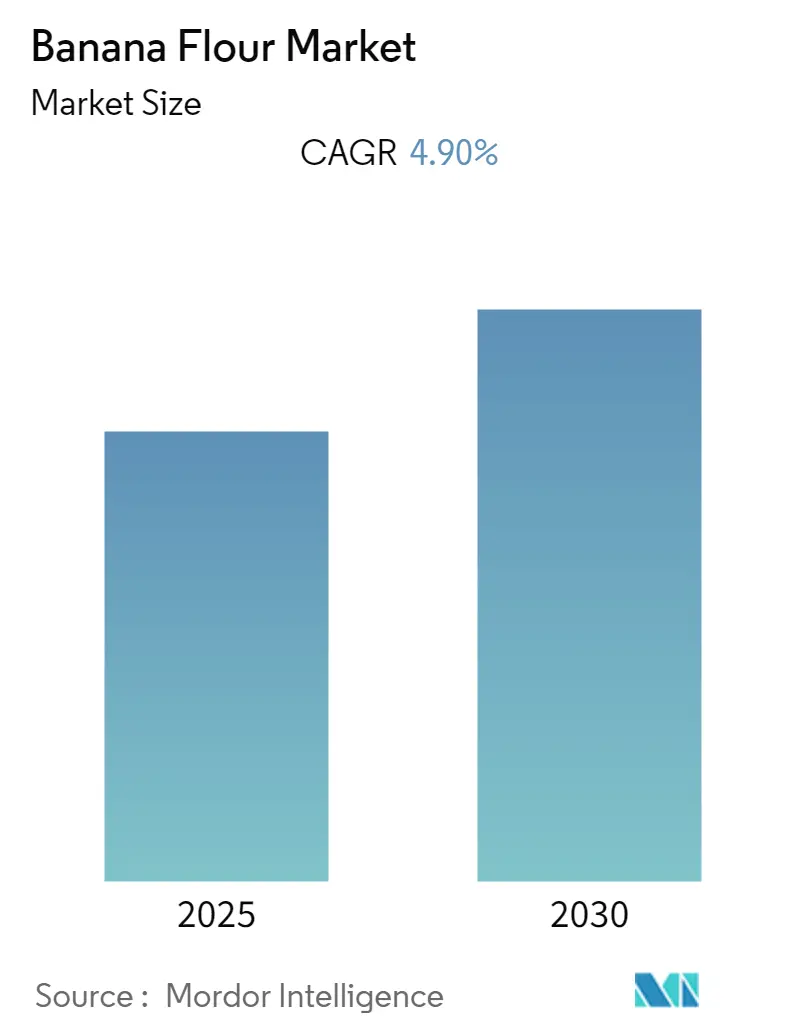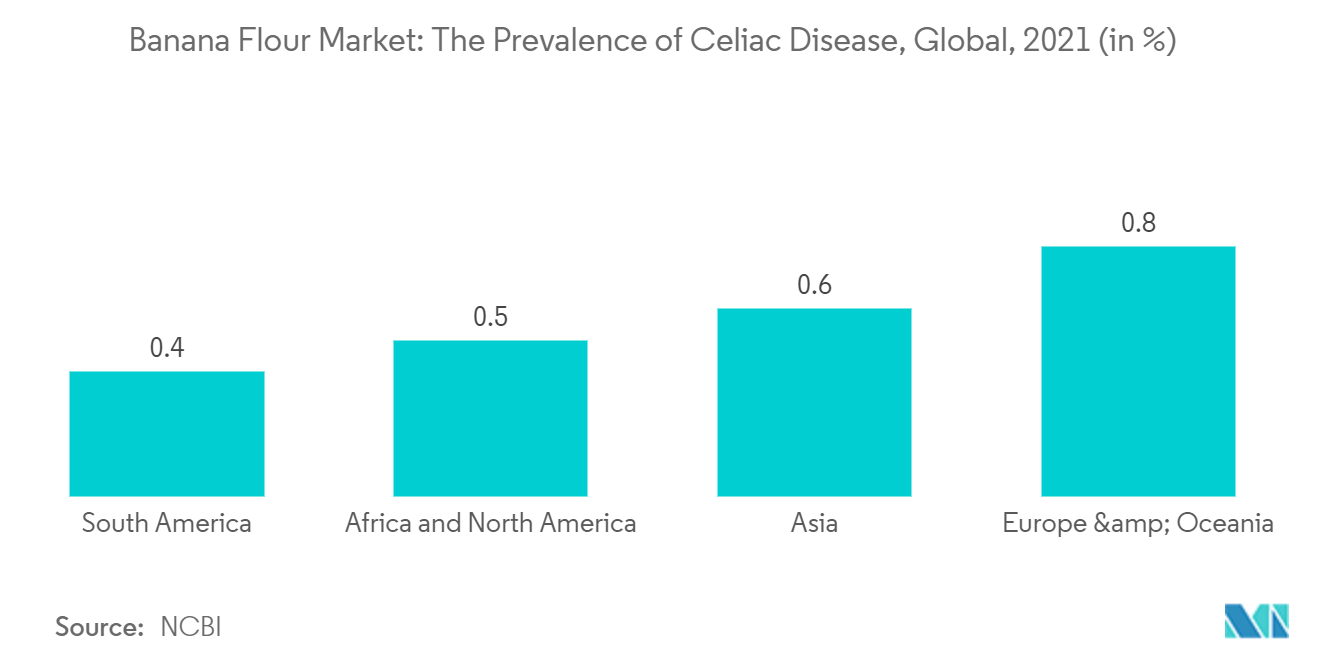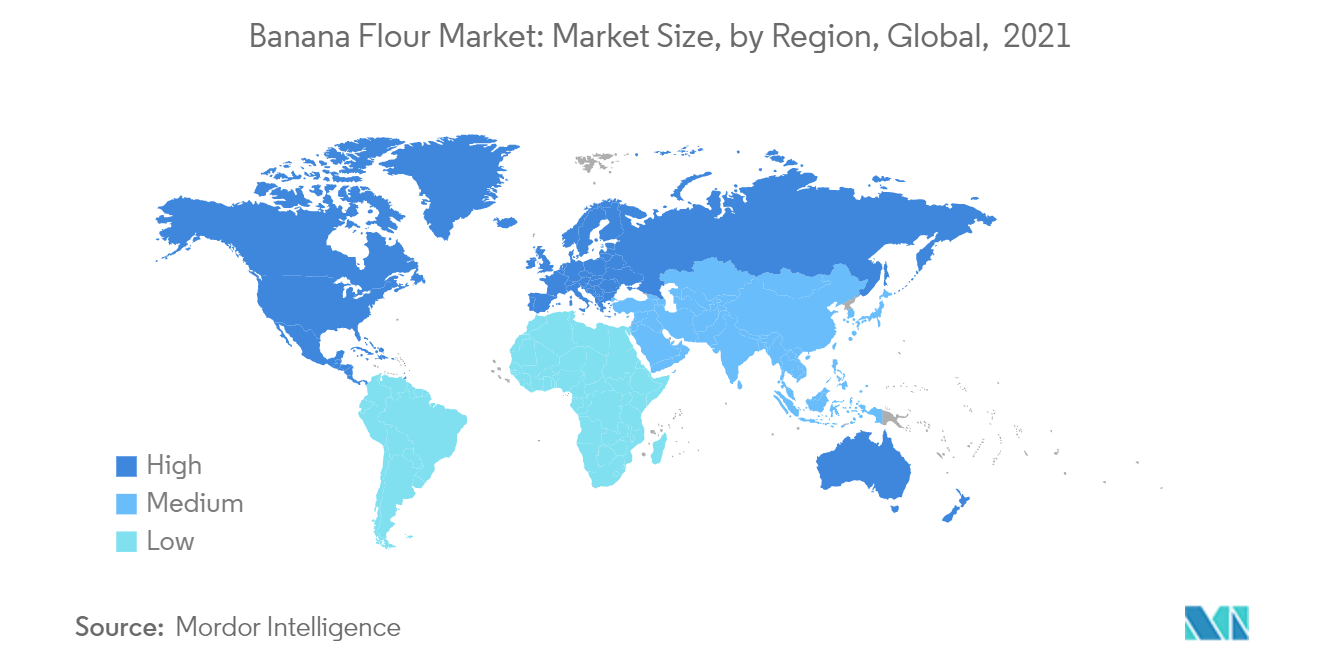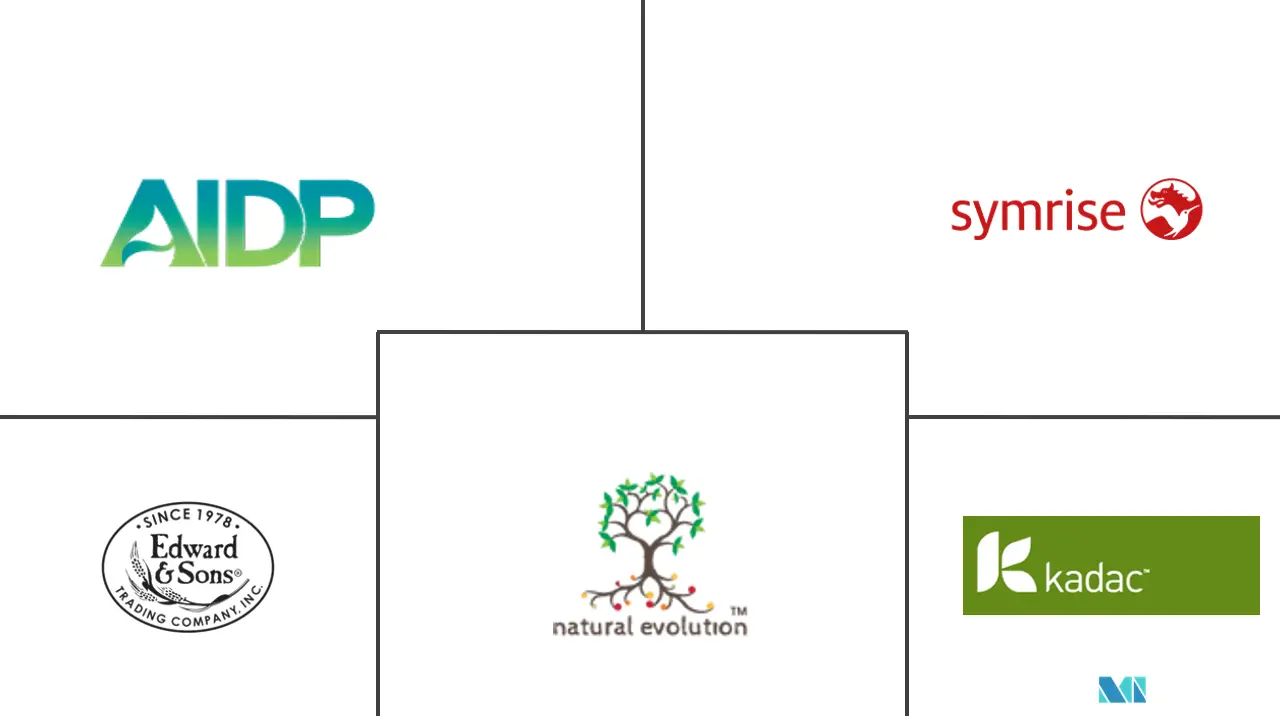
Banana Flour Market Analysis
The Banana Flour Market is expected to register a CAGR of 4.9% during the forecast period.
- The food consumption patterns have changed, and now consumers are more aware of following a healthy lifestyle. The rise of gluten-free products has increased the demand for banana flour. Consumers are progressively adopting healthy eating habits and increasing the demand for products such as banana flour.
- Moreover, the pandemic changed consumer perception toward food consumption, and choosing healthy ingredients has become a top priority. This encourages the flour food industry to utilize the excess stock by processing it into products like banana flour. Consumers' purchase volume of unripe banana flour products is increasing due to their high nutritional value.
- The increase in the preference for banana flour for babies regarding digestion and the rise in advanced and state-of-the-art manufacturing techniques accelerate the market growth. The high usage of the product in manufacturing various applications such as confectionery, filling and dressing, bakery and snacks, and infant food, among others, positively affects the banana flour market.
- Many key players have introduced organic banana flour as consumers become more aware of maintaining a healthy lifestyle. The major factor contributing to the growth of the banana flour market includes a rise in the production of green bananas. In addition, the rise in demand for gluten-free products also fuels the growth of the banana flour market. Banana flour is recognized as a functional ingredient because of its nutritional profile. Bananas contain prebiotic fiber, which is beneficial for gut health and reducing belly fat. An increasing preference for clean-label products in daily diet is driving the market.
Banana Flour Market Trends
Rise in demand of gluten free products
- The increasing obese population drives an increase in the demand for gluten-free products. Food and Agriculture Organization (FAO) states that about 6% of the US population is gluten intolerant. It's more common than celiac disease, which affects about 1% of the population. The use of whole green banana flour is up to 30% in substitution for wheat flour, significantly increasing the total dietary fiber content in bread. Consumers in generation Z and millennials are the most likely demographic to be following gluten-free nutrition rules.
- The shift in consumer preference for healthy and nutritious food products with additional medicinal benefits, such as antioxidants found in bananas that improve cellular health and lower damaging free radicals, is a key factor driving market revenue growth. In addition, food products made with bananas are gluten-free, which is becoming popular among health-conscious consumers and is another factor driving market revenue growth.
- The production of bananas increased, and the top five countries producing are India, China, Indonesia, Brazil, and Ecuador.
- Technology trends, including product innovations, make gluten-free products more palatable. There is an increase in the availability of gluten-free products owing to the increase in celiac disease patients. In addition, nutritional researchers and dietitians have discovered that banana flour (green variety) is a very good and useful source of resistant starch. Resistant starch refers to starch that does not break down in the small intestine and instead reaches the large intestine, in which it serves as fermentable dietary fiber. The impact of these drivers is expected to increase the demand for banana flour.

Asia Pacific Projected to be the largest Market
- Asia-Pacific banana flour markets are significantly supporting the growth of the global market. The region is considered to be among the major producer of bananas, which is projected to support the growth of the banana flour industry. Within the Asia-Pacific region, some of the leading consumer markets include India and Australia. Bananas are Australia's largest horticultural industry and highest-selling supermarket product.
- The Asia-Pacific, especially India, witnesses a large production volume of bananas every year, leading to the growth of the banana flour industry in the region. India is the top country for banana production in the world. According to Food and Agriculture Organization (FAO), as of 2021, bananas production in India was 33.1 million tonnes, accounting for 26.40% of the world's banana production. This factor plays a key role in augmenting the regional market's growth.
- In addition, there is a surge in demand for banana flour as the product is abundantly used to make infant food. The product is widely consumed in the region due to its rising use in bakery products like pastries, cakes, and others. Due to the rising trend and requirement for fitness among the regional countries, the demand for healthy products, such as banana flour, has bolstered. All these factors play a key role in augmenting the regional market's growth.

Banana Flour Industry Overview
The global banana flour market is fragmented, with companies focusing on leveraging online platforms to improve the visibility and reachability of their products. Key players differentiate their offerings and compete on different factors, including product offerings, ingredients, packaging, price, functionality, and marketing activities, to gain a competitive advantage. Thus, companies offer various characteristics and benefits in their products to attract customers to buy their banana flour, such as gluten-free and the United States Department of Agriculture (USDA)-certified labels. Key players operating in the market are KADAC Pty Ltd, AIDP, and Natural Evolution. Most of them focus on effective marketing and promotional strategies and the extension of their gluten-free offerings portfolio. Moreover, mergers and acquisitions targeting global expansion will remain a key strategy for several companies in the banana flour market.
Banana Flour Market Leaders
-
KADAC Pty Ltd
-
Natural Evolution
-
AIDP
-
Edward & Sons Trading Co.
-
Symrise AS
- *Disclaimer: Major Players sorted in no particular order
Banana Flour Market News
October 2021: The Indian Council of Agricultural Research (ICAR)-National Research Centre for Banana, Tiruchi, signed a memorandum of understanding (MoU) with Cake Bee, a bakery chain, for the transfer of technology to use banana powder in the bakery sector. The technology called foam mat drying - a low-cost novel technology developed by the institute, could be a feasible solution for producing cost-efficient banana powders from ripe and market-rejected bananas.
June 2021: Edward & Sons Trading Co., Inc. launched Let's Do Organic® Green Banana Flour. This is made from unripe organic bananas before their sugar content has fully developed, then dried at low temperatures to retain the benefits of their nutrients and resistant starch. Finally, it is milled into gluten-free flour, boasting a slightly sweet and wholesome taste. Cooking with Let's Do Organic® Green Banana Flour imparts a smooth texture and subtle, delicious flavor to bread, pancakes, pastries, pasta, and more.
March 2021: Kokos Natural launched NATIRÈL banana flour, a powder traditionally made of green bananas often used as a gluten-free replacement to wheat flour or as a source of resistant starch. It has a light texture and requires 25% less volume than wheat flour. It can be used in rotis, to thicken sauces and soups, baby foods, Indian farsan, bakery and confectionery products, sweets, ice-creams, and smoothies. Moreover, banana flour has been promoted by certain dieting trends, such as paleo and primal diets, and by some recent nutritional research.
Banana Flour Industry Segmentation
Banana flour refers to a form of a powder that is made from green bananas and is known to be rich in dietary fibers, carbohydrates, cellulose, essential amino acid, hemicellulose, and starch. These are also used as gluten-free products in various baked food. Banana flour has come up as an alternative to regular wheat flour. Banana flour is made by milling dehydrated green bananas, resulting in high levels of resistant starch.
The global banana flour market is segmented by type (conventional and organic) and application (food & beverage, dietary supplements, and other applications). The food and beverage segment is further bifurcated into bakery & confectionery, soups & dressings, functional beverages, and other applications. The study also covers the global analysis of the major regions, including North America, Europe, Asia-Pacific, South America, and the Middle-East and Africa.
The market sizing and forecasts have been done for each segment based on value (in USD Million).
| By Product Type | Conventional | ||
| Organic | |||
| By Application | Food & Beverage | Bakery & Confectionery | |
| Sauces & Dressings | |||
| Functional Beverages | |||
| Other Food & Beverages | |||
| Dietary Supplements | |||
| Other Applications | |||
| Geography | North America | United States | |
| Canada | |||
| Mexico | |||
| Rest of North America | |||
| Europe | United Kingdom | ||
| Germany | |||
| France | |||
| Russia | |||
| Italy | |||
| Spain | |||
| Rest of Europe | |||
| Asia-Pacific | India | ||
| China | |||
| Japan | |||
| Australia | |||
| Rest of Asia-Pacific | |||
| South America | Brazil | ||
| Argentina | |||
| Rest of South America | |||
| Middle-East and Africa | Saudi Arabia | ||
| South Africa | |||
| Rest of Middle East & Africa | |||
Banana Flour Market Research FAQs
What is the current Banana Flour Market size?
The Banana Flour Market is projected to register a CAGR of 4.9% during the forecast period (2025-2030)
Who are the key players in Banana Flour Market?
KADAC Pty Ltd, Natural Evolution, AIDP, Edward & Sons Trading Co. and Symrise AS are the major companies operating in the Banana Flour Market.
Which is the fastest growing region in Banana Flour Market?
North America is estimated to grow at the highest CAGR over the forecast period (2025-2030).
Which region has the biggest share in Banana Flour Market?
In 2025, the Asia-Pacific accounts for the largest market share in Banana Flour Market.
What years does this Banana Flour Market cover?
The report covers the Banana Flour Market historical market size for years: 2019, 2020, 2021, 2022, 2023 and 2024. The report also forecasts the Banana Flour Market size for years: 2025, 2026, 2027, 2028, 2029 and 2030.
Our Best Selling Reports
Banana Flour Industry Report
Statistics for the 2025 Banana Flour market share, size and revenue growth rate, created by Mordor Intelligence™ Industry Reports. Banana Flour analysis includes a market forecast outlook for 2025 to 2030 and historical overview. Get a sample of this industry analysis as a free report PDF download.




